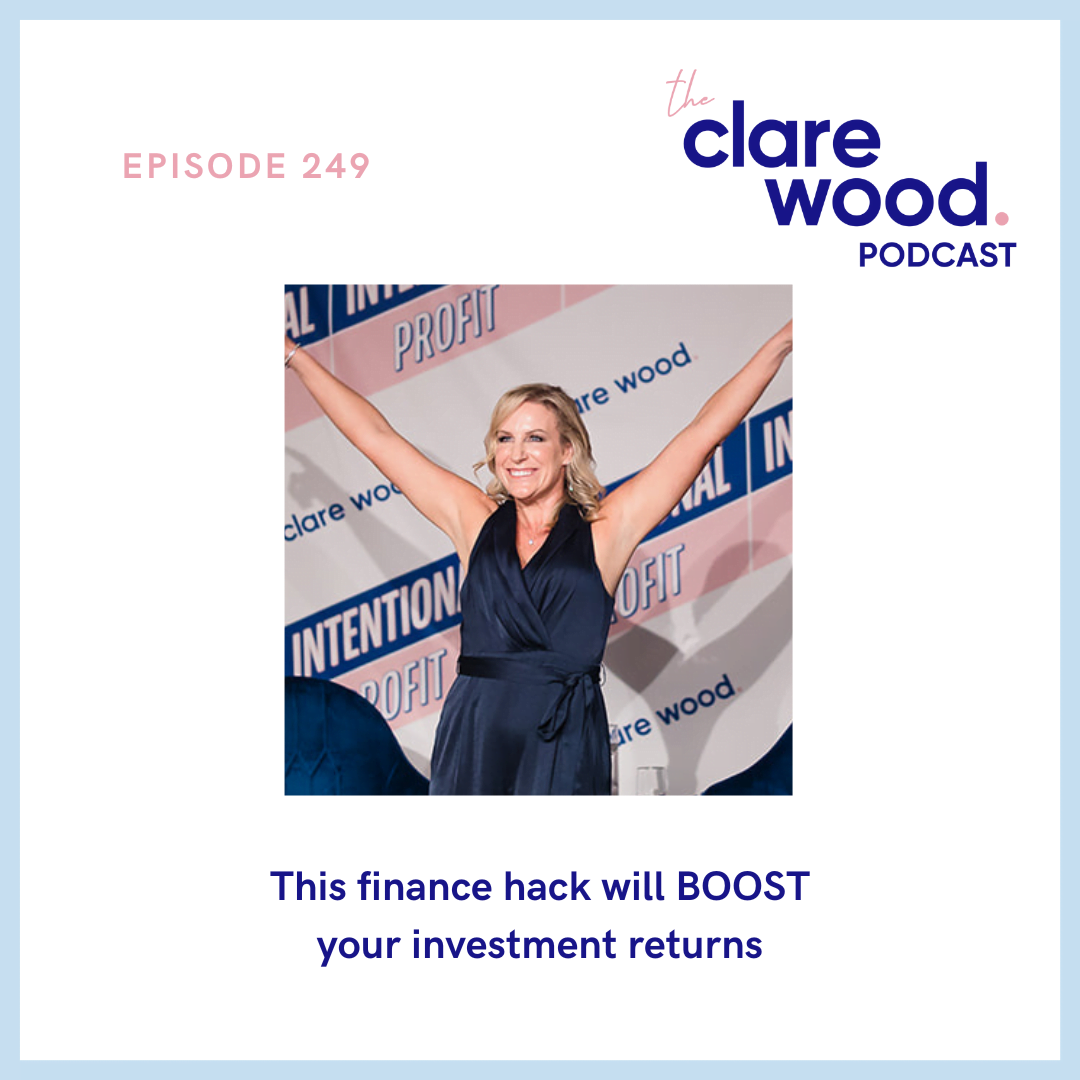As business owners, we need to make hard decisions everyday. One of the most challenging to make is around where to invest in your business to get the maximum return. In today’s episode, I share the tool I use to help you make profitable investment decisions.
In this Episode:
02.43: What is Return on Investment (ROI)?
07.06: Why you need to understand your shorter-term vs longer-term investments
10.21: How do you actually work out your ROI? This is the tool I use and teach others
15.48: Remember to factor in tax when doing your ROI calculator
Links:
Transcript
As business owners, we need to make hard decisions every day in our business and one of the most challenging decisions to make is around where to invest in your business to get the maximum return. In today’s episode of the podcast, I’m going to be chatting to you about a tool that I use and teach, which is called ROI or Return on Investment to help you make the most profitable investment decisions that you can for your business.
So, before we get started on today’s episode of the podcast, I just want to share a little bit about my background so that you have some context. I actually went straight from school to university and did a Bachelor of Commerce majoring in Accounting. From there I went and got my first job working in accounting and I started doing Post Graduate qualifications and I went on and did my CPA, which is called a Certified Practising Account.
I worked for many years as an accountant and eventually moved into a commercial space, and when I was working as both a commercial analyst and a commercial manager, one of the things that I used to do was help big businesses to work out the best way to spend their money. And to support them, to make decisions around when they do make big investments, how long it would take them to make that money back.
Now I’m sharing this because I want you to know that the tool we’re going to talk about today is the same thing that big global companies use in their decision making processes, and it’s something that I learned about in my days of studying accounting.
What is Return on Investment (ROI)?
What is Return on Investment (ROI)? Well, it’s calculating the return that you get on an investment. When you are having a look at your return on investment, as with many things in accounting land, you can cut it in two different ways. You can look at the cash return which is when you actually outlay the money and get the money back and you can also look at the overall profitability of a return on investment or of the investment.
When you are looking at calculating return on investment, a lot of times what particularly big businesses do, they look at it over a longer period of time. So when I was running these calcs, we would often be looking at a 10 year time frame and they were happy to get an ROI or a return on investment at the seven year mark. Now, if you’re in a position where you’re making investment decisions like that too, fantastic, how cool is it when you can lean in and make decisions like that without expecting a return on it straight away? If you are calculating ROI over many years you also need to factor in inflation because as you would know, particularly in the current economic climate that we are in right now, the cost of goods and services go up over time, the cost of rent, the cost of food etc. So because of that, a dollar today is not the same as a dollar in 10 years time.
For simplicity’s sake, for the purposes of today’s podcast episode, we’re just going to park that and I’m going to assume that most of you listening as small business owners are anticipating that you will get a return back on your investments within a relatively short period of time, so you don’t need to worry about that. It is important though to think about the fact that sometimes, even if you are anticipating a shorter return on your investment, something to consider is the fact that a lot of investments will pay you dividends for years and years to come, or hopefully they will.
For example, when I think back to when I first got started in business, the first major investment I made in my business was a decision to work with a business coach. In fact, I hired my first business coach before I had even made a single sale in. At the time that was such a scary investment to make at $1000 a month, which is what I paid way back then eight years ago. But I think about that decision to today and it has paid again and again and again and again. That business coach gave me the confidence to get out there and find my first client. That coach taught me how to sell and those are skills I still use today and skills that I give to my clients. So that investment that I made way back then is continuing to pay dividends for me 8 years later and not just for me, but it has a beautiful knock on effect to all of my clients. Also, I want to highlight this, because when we’re talking about calculating our a return on investment in the short term, a lot of times the investment decisions that you make can pay, you know dividends years and years later.
Why you need to understand your shorter-term vs longer-term investments
The reason why it’s important to understand your return on investment, is there are different ways that we make investment decisions in our business. A lot of them are things where we pay money and we are straight away anticipating that we will get a return.
An example of this, if you run paid advertising like Facebook ads or Google ads, a lot of times you are paying money in the anticipation that it will lead to more people joining your email list, your course or signing up to work with. While we recognise that sometimes there can be a bit of a lead time on this, a lot of times when you make a decision like that, you’re anticipating that it will have a pretty quick return on the investment.
Similarly for me, if I’m doing something like investing to work with a mentor, I’m expecting that in a relatively short period of time I’ll be recovering the cost of that investment. I’m usually working with a coach or a mentor because I want to have an upper level in my sales results.
There are other times we make decisions with a longer term view.
Some examples of this might be investing in brand in photography, working with a lawyer. So for example you might go and pay a lawyer to make you up a new contract. You’re not really expecting that you’ll pay for a contract and that investment is going to pay dividends for you in the short term. However, if you don’t have good legal foundations in place, down the track, it could cost you really dearly.
Similarly, with things like imagery and branding your website. If you aren’t investing in your brand, over time, the value of your business will start to decline because it won’t be as aesthetically pleasing and as attractive to your potential clients. However, just because I go out and invest a couple of $1000 in a photoshoot, I don’t really expect that I’ll post those new photos and people go, wow, she’s got new photos.
Sometimes there are these shorter term investment decisions that we make and others are longer term, but nonetheless, I think it’s still important to consider what the ROI or the return that you are anticipating you will get will be and over what time frame.
Now this is the name of my book. It’s called Intentional Profit and I think that there’s a time and place to make both kind of decisions, short-term investment decisions and long term investment decisions. But the key thing that I want you to do is to do it with intention to have a plan in place. And this tool, your ROI can be a really fantastic way to make that decision.
How do you actually work out your ROI? This is the tool I use and teach others
So how exactly does ROI work? Well, essentially what you do is put into your formulation the cost of the investment. And when you’re doing so, it’s important to capture the whole cost.
Let me give you an example of what I mean here. I mentioned before getting a photoshoot done. Now a photographer might be $2000, and if I was to plug the $2000 in and work out my the potential sales uplift. Buy I haven’t actually captured all of the costs because when I do a photoshoot, I do it well. I hire an assistant to come and help me on the day, I usually hire a venue, I will buy props for the day, I will buy new outfits, I will also hire a hair and makeup artist so that I look and feel my best on the day. So as you can see, it’s not just the cost of the photographer there’s a whole bunch of other costs too.
And similarly with other investments. There might be other things that you need to factor in. For example, if you’re getting a new website, it’s probably not just the cost of the web design that you need to factor. You might also need to, have some strategic marketing work done to have a think about the holistic direction of the website. You might need to get some legal work done to make sure that you are covering all of the rules around privacy and things like that. You might need to hire an expert to help you set up some of the tech side. Or your funnels behind the scenes. You might need to invest in photography as well, so you’ve got some beautiful new images to put on your website. So that’s the first thing that you need to factor in. Have you actually captured all of the costs?
After you’re pretty confident that you have got all of those costs, it’s really important to think about the timing of the outflow of those cash outflows. So is this the kind of investment where you pay all of the money upfront? Or will you have costs overtime? And what does the timing of those look like and what I mean by that is let’s come back to that website example, you might have an upfront payment that you make, but you might have a couple of progress payments along the way. So you might not pay for the website in entirety. So think about the timing of the investment outflows as well.
And then the last thing to capture in your RY calculations is the anticipated inflows. So when are you expecting the uplift or the returns to come in off the back of that investment now as I mentioned earlier, sometimes this is relatively easy if you were saying, OK, I’m hiring a coach and in the next three months I wanna be at least covering their costs and within six months I wanna be doubling my sales or getting a 50% increase on my sales.
Now a lot of people get really stuck here because they try and over engineer this. As someone who used to do financial modelling, which is what we’re talking about, modelling what numbers look like, trying to forecast the future, let me tell you that the best finance expert in the world cannot accurately budget or forecast the future. There always is a bit of guesswork that goes into this, and one of the biggest mistakes that you can make is not doing this exercise because you want it to be perfect. You just have to use a best guess as to what the future looks like based on the information that you have. When I was doing a lot of this work for big, big companies, there were so many variables that we couldn’t possibly predict, so what we did was we would just use the best information we had available at the time. And also we’d play around with like, what would it look like if you know if the cost of product went up 20% or went down 20%, what would it look like if we didn’t, if we only got a sales uplift of 10% rather than 50%? That’s what financial modelling is, is it’s playing around with what some of those numbers look like and using the best information available at the time. There’s always risk involved in making decisions, but it’s trying to make the best decision possible based on the information that you have.
Remember to factor in tax when doing your ROI calculator
A couple of final things that I want to mention in here. One thing that you must remember is to consider the taxation implications. So let’s just say that you are spending a $1000 and expecting that that investment will deliver you $2000 worth of sales. It’s important to remember that $2000 worth of sales isn’t really $2000 because you have to pay tax on that amount. Remember to factor that into your calculations, and if you are going and doing budgeting or having a look at the ROI of a particular investment, I always recommend that you get your financial professional or your accountant to check over your numbers. Do a sense check, forecast the taxation implication and just make sure that there is some robustness to the calcs that you have done.
ROI is a tool that I use regularly in my business. Anytime I’m looking to make a big decision, if I want to host a retreat, I go and forecast the expenses, forecast the anticipated revenue, and work out if it’s a worthwhile investment for me to make. If I’m looking to hire a coach at the moment, I’ve recently invested to do a VIP day and I’m actually flying overseas to work with a mentor I really wanna work with and when I was calculating that again, I said this is the investment. How many extra sales would I need to get in my business to make this a worthwhile investment? It’s a really cool tool and a really great way to massively up level the quality of the investment decisions that you make in your business.
ROI is just one example of how knowing your numbers is so important to set yourself up in business for long term success over the coming few episodes of the podcast, I’m going to be talking to you more and more about the power of numbers, and I know I’ve mentioned it here on the podcast before, but if you want to get some more hacks around how to be a master of your money, come and join my free broadcast channel over on Instagram because I share exclusive content with those inside the broadcast channel on the regular, go to @clare_wood_coach.
Thanks so much for tuning in to today’s episode of the podcast. As always, if you enjoyed this, got some value out of it, I’d be extremely grateful if you could share it with a friend, some friends, or your audience, and make sure you do. Tag me if you share it on social media so I can come on over and say big thank you to you. Thanks so much for tuning in to today’s episode of the podcast and I can’t wait to chat to you again next week.







